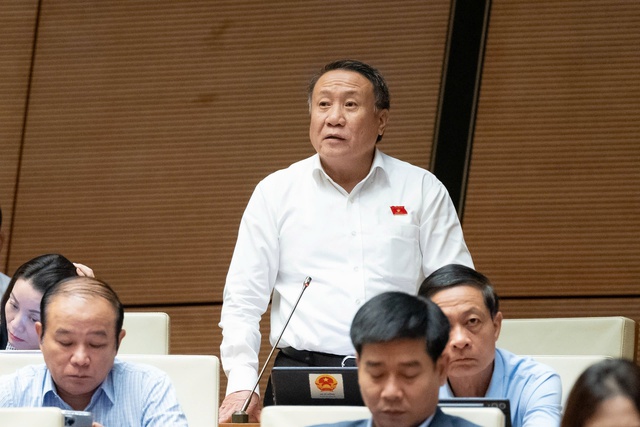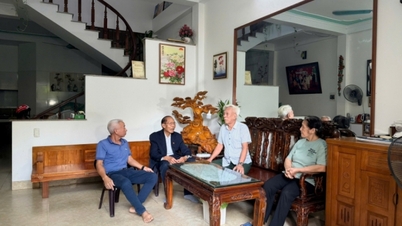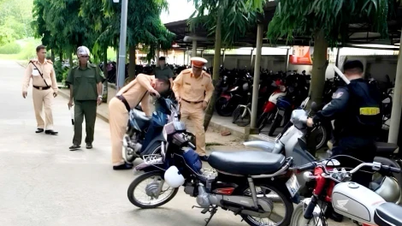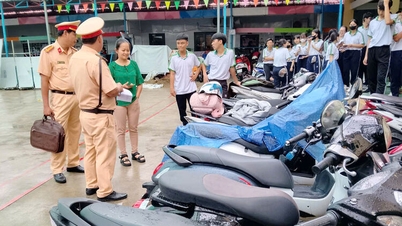From January 1, 2026, according to the provisions of the Law on Road Traffic Order and Safety , when transporting children under 10 years old and under 1.35 m tall in a car, the driver must use and instruct on the use of appropriate safety equipment for children .
This law defines a child restraint device as a device capable of securing a child in a sitting or lying position in a motor vehicle, designed to reduce the risk of injury to the user in the event of a collision or sudden deceleration of the vehicle, by restricting the movement of the child's body.
Delegate Ha Sy Dong, Quang Tri delegation
PHOTO: GIA HAN
Child seat regulations should not be rigid.
Discussing the draft law amending 10 laws on security and order, delegate Ha Sy Dong (Quang Tri delegation) said that most developed countries have regulations on equipping children with safety devices when traveling by car. However, Mr. Dong pointed out the reality in these countries, the rate of car use is very high, there are almost no motorbikes. Meanwhile, the rate of motorbike use in Vietnam is still high.
Mr. Dong said that if the regulations on child car seats are too rigid, it could cause many families to switch to transporting children by motorbike, instead of by car or taxi. This would increase the risk of accidents for children.
Citing his opinion, Mr. Dong said the above situation happened in Indonesia or the Philippines, when there was a regulation requiring child seats, the rate of parents taking children to school by motorbike increased by 15-30%.
Mr. Dong further analyzed that according to the old Regulation 123/2024 of the Ministry of Transport , child seats have 4-5 different sizes depending on the weight of the child. If a taxi is required to be equipped with child seats, there must be at least 4-5 seats of different sizes, "this is completely impossible". Or equipping one seat cannot meet the needs when there are 2 or more children.
Not to mention, taxis serve tourists and are often combined with other forms of transportation such as airplanes. If parents are required to bring a child seat, they will have to bring it on the plane and have to carry the seat with them throughout the trip.
Or some poor families, without a private car, have to call a taxi to take their children to get vaccinated, get medical treatment or travel on rainy and cold roads. The number of taxis equipped with child seats is often small, so calling is more difficult, the time and distance of travel without passengers is longer, so the fare is also higher...
Based on the above facts, the delegate from Quang Tri suggested considering the experience of many countries, which is to eliminate the mandatory obligation to equip child seats for taxis or technology cars.
Delegate Nguyen Van Canh, Gia Lai delegation
PHOTO: GIA HAN
Is it safer to walk against the flow?
Discussing further about the draft law, delegate Nguyen Van Canh (Gia Lai delegation) stated that recently the Traffic Police Department (Ministry of Public Security) has painted speed limit signs on the road surface or stop signs on branch roads leading to main roads, to help drivers drive at the correct speed and observe better when entering lanes.
Currently, traffic through small alleys is very crowded, intersections have limited visibility so accidents are very likely to happen. Many alleys have 4-5 accidents every day, causing injuries to drivers, damage to vehicles, and damage to houses.
To limit this, Mr. Canh suggested that in alleys where accidents frequently occur, if priority signs cannot be placed, paint lines to ensure safety.
Signs and lane markings painted on the road surface have the same value as road signs.
At the same time, the delegate proposed a draft law to supplement the regulation on "paint lines showing road signs", in order to serve as a legal basis for the proposal to paint lines as mentioned above.
Mr. Canh also said that Vietnam currently has many roads without sidewalks or curbs for pedestrians, especially in rural areas. There are many cases where people walk on the road in the direction of traffic and are hit by cars from behind, causing injuries and even death.
The delegate proposed the following regulation: in cases where there is no sidewalk, curb, or road reserved for pedestrians, pedestrians must walk against the flow of traffic, close to the left edge of the road in their direction of travel, and walk in single file.
"If walking against traffic flow, pedestrians can always see oncoming vehicles. If there is a risk of collision, they have enough time to jump out of the road to avoid the collision," Mr. Canh explained.
Source: https://thanhnien.vn/de-nghi-mien-lap-ghe-tre-em-voi-taxi-xe-cong-nghe-185251117163615046.htm





![[Photo] General Secretary To Lam and National Assembly Chairman Tran Thanh Man attend the 80th Anniversary of the Traditional Day of the Vietnamese Inspection Sector](https://vphoto.vietnam.vn/thumb/1200x675/vietnam/resource/IMAGE/2025/11/17/1763356362984_a2-bnd-7940-3561-jpg.webp)










































































































Comment (0)